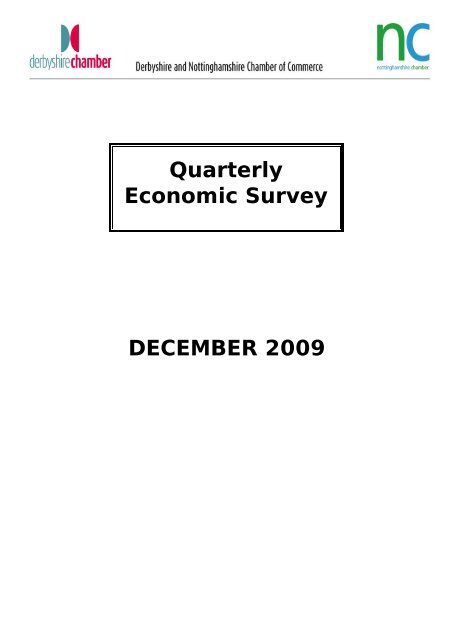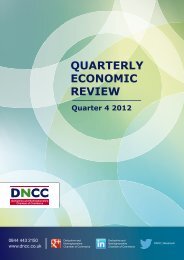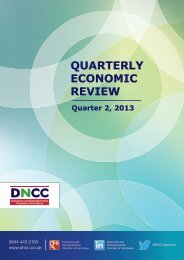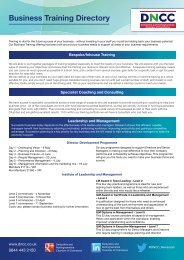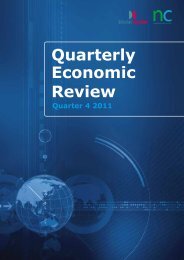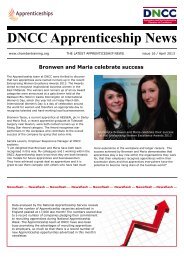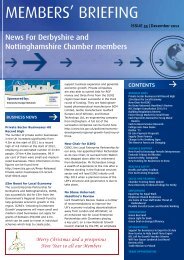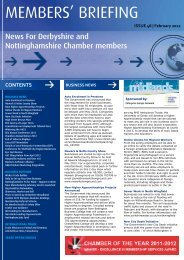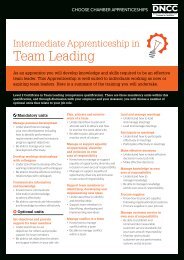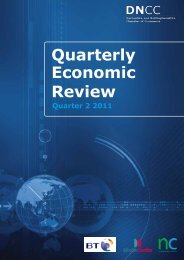Q4 Full Report - Derbyshire and Nottinghamshire Chamber of ...
Q4 Full Report - Derbyshire and Nottinghamshire Chamber of ...
Q4 Full Report - Derbyshire and Nottinghamshire Chamber of ...
- No tags were found...
Create successful ePaper yourself
Turn your PDF publications into a flip-book with our unique Google optimized e-Paper software.
QuarterlyEconomic SurveyDECEMBER 2009
INDEXContentsPage(s)1. Introduction 32. Summary <strong>of</strong> results 43. Performance in the last three months 5-84. Trends analysis 9• UK sales 9• Export sales 10• Employment levels 11• Recruitment 12-13• Cash flow 145. Expectations for the next quarter 15-16• UK orders 17• Export orders 18• Labour force 19• Price pressures 20• Investment intentions 21-22• Confidence levels 23-246. Skills, Education <strong>and</strong> Business Engagement 25-267. Proposed use <strong>of</strong> business rates supplements 278. Postal Strike impacts 27-282
1. Introduction<strong>Derbyshire</strong> <strong>and</strong> <strong>Nottinghamshire</strong> <strong>Chamber</strong> <strong>of</strong> Commerce (DNCC) surveys itsMembers quarterly on the latest business trends affecting businesses in the twocounties. This report sets out the findings for the fourth quarter <strong>of</strong> 2009 with thesurvey being conducted between 16 November <strong>and</strong> 9 December 2009. Businesseswere surveyed by postal <strong>and</strong> on-line surveys.There were 359 respondents to the Quarterly Economic Survey, 216 from<strong>Derbyshire</strong> <strong>and</strong> 143 from <strong>Nottinghamshire</strong>. There were 225 respondents fromservice sector businesses <strong>and</strong> 134 from manufacturers.The findings <strong>of</strong> this survey are consolidated with the results obtained by other<strong>Chamber</strong>s into the national British <strong>Chamber</strong>s <strong>of</strong> Commerce Survey which providesguidance to Government, Bank <strong>of</strong> Engl<strong>and</strong> <strong>and</strong> other key policy makers.The survey also included a focus on skills’ shortages <strong>and</strong> priorities for expenditure;the potential use for business rate supplements <strong>and</strong> the impact <strong>and</strong> responses tothe postal strike.For more information about the survey please contact John Dowson, Head <strong>of</strong> Policy<strong>and</strong> Representation on 01159 330049 or on john.dowson@dncc.co.uk3
Business Conditions2. Summary <strong>of</strong> Results• The improvements in the <strong>Derbyshire</strong> <strong>and</strong> <strong>Nottinghamshire</strong> economyflattened out in the fourth quarter <strong>of</strong> 2009. The outlook for the first quarter<strong>of</strong> 2010 is slightly better, however, there is little sign that employmentlevels are going to improve significantly <strong>and</strong> businesses are slightly lessconfident about future pr<strong>of</strong>itability.• Net cash flow balances are improving across both counties but there arestill more businesses reporting worsening rather than improving cash flow.• Overall net balances for both domestic <strong>and</strong> export orders are higher thanthe previous quarter.• Investment in both machinery <strong>and</strong> training are increasing but remain lowerthan both regional <strong>and</strong> national levels.• The confidence levels <strong>of</strong> <strong>Derbyshire</strong> <strong>and</strong> <strong>Nottinghamshire</strong> businesses forfuture turnover <strong>and</strong> pr<strong>of</strong>itability are higher than the East Midl<strong>and</strong>s levels.• Net job losses are expected in the construction <strong>and</strong> engineering sectors <strong>and</strong>net job growth in financial <strong>and</strong> business services. North <strong>Derbyshire</strong> looksset for net job losses whilst job growth is expected in Amber Valley,Erewash <strong>and</strong> Nottingham City in the next three months.Skills• If funding is limited, businesses believe that supporting training in theexisting workforce <strong>and</strong> higher education are the top priorities forexpenditure on skills.• The top priorities for skills that need improving in <strong>Derbyshire</strong> <strong>and</strong><strong>Nottinghamshire</strong> businesses are customer care <strong>and</strong> managerial <strong>and</strong>supervisory skills.• Of the changes in education, businesses know most about nationalapprenticeships (62%) <strong>and</strong> least about the 14-19 Diploma (29%).Business Rate Supplements• Overall only 14% <strong>of</strong> businesses believe that business rate supplementsshould be used to fund major sporting venues locally with 62% opposing.Postal Strike• Only 24% <strong>of</strong> businesses changed their operations as a result <strong>of</strong> the postalstrikes.• Overall 13% <strong>of</strong> all <strong>Derbyshire</strong> <strong>and</strong> <strong>Nottinghamshire</strong> businesses are usingalternative deliverers following the postal dispute whilst 23% are nowmaking or receiving payments electronically, using electronic exportdocumentation or trading more online.4
3. Performance in the last three monthsThe table below shows the changes in the net variances* on a number <strong>of</strong>indicators <strong>of</strong> performance in the last quarter <strong>and</strong> expectations for the next quarter.Quarterly Economic SurveyDecember 2009DNCC<strong>Nottinghamshire</strong><strong>Derbyshire</strong>ManufacturersServicesPerformances in the last quarterUK sales 0 5 -4 -2 4Export sales -6 -11 -3 -2 -9Workforce changes -1 -7 1 -1 -1Businesses recruiting 0 -5 1 5 -4Recruitment difficulties3 -6 10 12 1Cash flow 11 16 6 11 11<strong>Full</strong> capacity 0 2 -2 -2 1Expectations for the next quarterUK orders 7 12 2 0 10Export orders 2 6 -5 5 -4Future workforce -4 3 -7 1 -6Investment in machinery 8 5 10 5 7Investment in training 5 2 5 4 2Confidence in turnover 2 13 -6 5 1Confidence in pr<strong>of</strong>itability -3 13 -15 -3 -2Expectations for prices 0 4 -4 1 1• Net variance is the difference between the percentages <strong>of</strong> businesses reportingimproving or increasing positions <strong>and</strong> those reporting worsening or decreasing positions.5
<strong>Derbyshire</strong> <strong>and</strong> <strong>Nottinghamshire</strong>Most <strong>of</strong> the net variances considering performances in the last quarter had notchanged much or at all from the September 2009 Quarterly Economic Survey. Anotable exception was the improvement in business cash flow in both sectors <strong>and</strong>counties. There was also a slight deterioration in export sales in the quarter.Changes from September Quarter 2009All <strong>Derbyshire</strong> <strong>and</strong> <strong>Nottinghamshire</strong> Businesses-10 -5 0 5 10 15Net % balance change<strong>Full</strong> capacityCashflowRecruitment difficultiesBusinesses recruitingEmployment levelsExport salesUK SalesThere was a slight increase in the number <strong>of</strong> manufacturers that had attempted torecruit but a 12% increase in the number reporting difficulties in employingworkers with appropriate skills.Changes from September Quarter 2009All Manufacturing Businesses-5 0 5 10 15Net % balance change<strong>Full</strong> capacityCashflowRecruitment difficultiesBusinesses recruitingEmployment levelsExport salesUK Sales6
Fewer service sector businesses attempted to recruit staff in the last quarter.The biggest negative net variance for service sector businesses was export saleswhere 9% more businesses reported lower sales. There was, however, a slightimprovement in sales in the UK market.Changes from September Quarter 2009All Service Sector Businesses-10 -5 0 5 10 15Net % balance change<strong>Full</strong> capacityCashflowRecruitment difficultiesBusinesses recruitingEmployment levelsExport salesUK Sales<strong>Derbyshire</strong>There were slight reductions in sales in the last quarter in both UK <strong>and</strong> exportmarkets. Employment levels <strong>and</strong> the number <strong>of</strong> businesses attempting to recruitwere largely the same but there was a 10% increase in the number <strong>of</strong> <strong>Derbyshire</strong>businesses reporting difficulties in recruiting workers with appropriate skills.Changes from September Quarter 2009All <strong>Derbyshire</strong> Businesses-5 0 5 10 15Net % balance change<strong>Full</strong> capacityCashflowRecruitment difficultiesBusinesses recruitingEmployment LevelsExport salesUK Sales7
<strong>Nottinghamshire</strong>More <strong>Nottinghamshire</strong> businesses reduced employment levels <strong>and</strong> fewer attemptedto recruit workers in the last quarter. There was also a reduction in thoseexperiencing difficulties when recruiting.The biggest negative variance was export sales whilst there was a slightimprovement in sales in the UK market. The biggest positive change was in cashflow where 7% more reported improving <strong>and</strong> 9% fewer worsening positions.Changes from September Quarter 2009All <strong>Nottinghamshire</strong> Businesses-15 -10 -5 0 5 10 15 20Net % balance change<strong>Full</strong> capacityCashflowRecruitment difficultiesBusinesses recruitingEmployment levelsExport salesUK Sales8
4. Trends AnalysisUK SalesSales in the UK market did not change in the quarter with the same percentage(30%) <strong>of</strong> businesses reporting improving <strong>and</strong> worsening positions. Service sectorbusinesses are more positive than manufacturers where there are still morecompanies reporting worsening rather than improving sales.UK Sales By Sector3010Net %-10-30Dec 2007Mar 2008June 2008Sept 2008Dec 2008Mar 2009June 2009Sept 2009Dec 2009-50Manufacturing Services CompositeFewer <strong>Derbyshire</strong> businesses reported higher UK sales whilst 2% more<strong>Nottinghamshire</strong> businesses improved sales <strong>and</strong> 3% fewer reported worseningsales.UK SalesAll <strong>Derbyshire</strong> <strong>and</strong> <strong>Nottinghamshire</strong> Businesses4020Net %0-20Dec 2007Mar 2008June 2008Sept 2008Dec 2008Mar 2009June 2009Sept 2009Dec 2009-40DNCC <strong>Nottinghamshire</strong> <strong>Derbyshire</strong>9
Export SalesOverall, export sales were slightly lower in the last 3 months. The samepercentage (17%) <strong>of</strong> manufacturing businesses reported improving <strong>and</strong> worseningexport sales. There was a reduction in service sector exports but there are stillmore businesses reporting higher rather than lower export sales.40Export Sales by Sector20Net %0-20Dec 2007Mar 2008June 2008Sept 2008Dec 2008Mar 2009June 2009Sept 2009Dec 2009-40Manufacturing Services CompositeExport Sales fell in the both counties. The biggest deterioration was in<strong>Nottinghamshire</strong> where the percentage (14%) <strong>of</strong> businesses reporting improving<strong>and</strong> worsening sales is the same.40Export SalesAll <strong>Derbyshire</strong> <strong>and</strong> <strong>Nottinghamshire</strong> Businesses20Net %0-20Dec 2007Mar 2008June 2008Sept 2008Dec 2008Mar 2009June 2009Sept 2009Dec 2009-40DNCC <strong>Nottinghamshire</strong> <strong>Derbyshire</strong>10
Employment LevelsOverall, employment levels changed little from the September quarter with a 1%reduction in both sectors. Employment in the manufacturing sector remains weakwith 15% increasing <strong>and</strong> 27% reducing employment levels. The correspondingfigures for the service sector are 18% <strong>and</strong> 22%.Employment levels in last 3 months by sector4020Net %0-20Dec 2007Mar 2008June 2008Sept 2008Dec 2008Mar 2009June 2009Sept 2009Dec 2009-40Manufacturing Services CompositeEmployment balances in <strong>Derbyshire</strong> continued to improve in the quarter whilstthey deteriorated slightly in <strong>Nottinghamshire</strong>. Only 19% <strong>and</strong> 13% respectively <strong>of</strong><strong>Derbyshire</strong> <strong>and</strong> <strong>Nottinghamshire</strong> businesses increased <strong>and</strong> 23% <strong>and</strong> 26% reducedemployment levels in the quarter.40Employment levels in the last 3 monthsAll <strong>Derbyshire</strong> <strong>and</strong> <strong>Nottinghamshire</strong> Businesses20Net %0-20Dec 2007Mar 2008June 2008Sept 2008Dec 2008Mar 2009June 2009Sept 2009Dec 2009-40DNCC <strong>Derbyshire</strong> <strong>Nottinghamshire</strong>11
RecruitmentOverall there was no change in the percentages <strong>of</strong> businesses that attempted torecruit in the quarter <strong>and</strong> a 3% increase in those reporting recruitment difficulties.The main difficulties in recruiting in <strong>Nottinghamshire</strong> <strong>and</strong> the service sector arepr<strong>of</strong>essional, managerial <strong>and</strong> clerical <strong>and</strong> in <strong>Derbyshire</strong> <strong>and</strong> the manufacturingsector the main difficulty is recruiting skilled manual <strong>and</strong> technical workers.More <strong>Derbyshire</strong> <strong>and</strong> manufacturing businesses attempted to recruit <strong>and</strong> 38% <strong>and</strong>37% respectively experienced recruitment difficulties. Fewer <strong>Nottinghamshire</strong> <strong>and</strong>service sector businesses recruited <strong>and</strong> whilst 34% <strong>and</strong> 37% respectively reporteddifficulties in recruiting workers with the appropriate skills.80RecruitmentAll <strong>Derbyshire</strong> <strong>and</strong> <strong>Nottinghamshire</strong> Businesses60Net %40200Dec 2007Mar 2008June 2008Sept 2008Dec 2008Mar 2009June 2009Sept 2009Dec 2009Tried to recruitDifficulty in recruiting80RecruitmentAll <strong>Derbyshire</strong> Businesses60Net %40200Dec 2007Mar 2008June 2008Sept 2008Dec 2008Mar 2009June 2009Sept 2009Dec 2009Tried to recruitDifficulty in recruiting12
80RecruitmentAll <strong>Nottinghamshire</strong> Businesses60Net %40200Dec 2007Mar 2008June 2008Sept 2008Dec 2008Mar 2009June 2009Sept 2009Dec 2009Tried to recruitDifficulty in recruitingRecruitment: All Manufacturing BusinessesNet %806040200Dec 2007Mar 2008June 2008Sept 2008Dec 2008Mar 2009June 2009Sept 2009Dec 2009T ried to RecruitDifficulty recruitingRecruitment: All Service Sector Businesses8060Net %40200Dec 2007Mar 2008June 2008Sept 2008Dec 2008Mar 2009June 2009Sept 2009Dec 2009T ried to RecruitDifficulties Recruiting13
Cash FlowOverall net cash flow balances improved by 11% with 1% more reportingimproved positions <strong>and</strong> 10% fewer worsening cash flow. <strong>Nottinghamshire</strong> <strong>and</strong>service sector businesses are more positive than <strong>Derbyshire</strong> businesses <strong>and</strong>manufacturers but in both counties <strong>and</strong> sectors there are still more businessesreporting worsening rather than improving cash flow balances.Cashflow by Sector20Net Balance %0-20Dec 2007Mar 2008June 2008Sept 2008Dec 2008Mar 2009June 2009Sept 2009Dec 2009-40Manufacturing Services Composite20CashflowAll <strong>Derbyshire</strong> <strong>and</strong> <strong>Nottinghamshire</strong> BusinessesNet Balance %0-20Dec 2007Mar 2008June 2008Sept 2008Dec 2008Mar 2009June 2009Sept 2009Dec 2009-40DNCC <strong>Nottinghamshire</strong> <strong>Derbyshire</strong>14
5. Expectations for the next quarter<strong>Derbyshire</strong> <strong>and</strong> <strong>Nottinghamshire</strong>Most <strong>of</strong> the net variables looking ahead for the next quarter have improved. Onlyconfidence in pr<strong>of</strong>itability <strong>and</strong> export orders reduced slightly. The notableimprovements are investment in machinery <strong>and</strong> UK orders.Expectations for the next quarterAll <strong>Derbyshire</strong> <strong>and</strong> <strong>Nottinghamshire</strong> businesses-10 -5 0 5 10Net % balance changeExpectations for pricesConfidence in pr<strong>of</strong>itabilityConfidence in turnoverInvestment in trainingInvestment in machineryEmployment levelsExport OrdersUK OrdersWith the exception <strong>of</strong> confidence in pr<strong>of</strong>itability all <strong>of</strong> the variables formanufacturers improved slightly.Expectations for the next quarterAll Manufacturing Sector Businesses-5 0 5 10Net % balance changeExpectations for pricesConfidence in pr<strong>of</strong>itabilityConfidence in turnoverInvestment in trainingInvestment in machineryEmployment levelsExport OrdersUK OrdersService sector businesses report slight deteriorations in export orders <strong>and</strong>employment levels <strong>and</strong> improvements in UK orders <strong>and</strong> investment plans formachinery.Expectations for the next quarterAll Service Sector Businesses-10 -5 0 5 10 15Net % balance changeExpectations for pricesConfidence in pr<strong>of</strong>itabilityConfidence in turnoverInvestment in trainingInvestment in machineryEmployment levelsExport OrdersUK Orders15
<strong>Derbyshire</strong><strong>Derbyshire</strong> businesses’ confidence in future pr<strong>of</strong>itability levels has reduced fromthe positive September Quarter.On the positive side businesses are increasing investment plans for bothmachinery <strong>and</strong> training.Expectations for the next quarterAll <strong>Derbyshire</strong> Businesses-20 -15 -10 -5 0 5 10 15Net % balance changeExpectations for pricesConfidence in pr<strong>of</strong>itabilityConfidence in turnoverInvestment in trainingInvestment in machineryEmployment levelsExport OrdersUK Orders<strong>Nottinghamshire</strong>All the variables for <strong>Nottinghamshire</strong> businesses improved with net balanceimprovement <strong>of</strong> 13% for confidence in both pr<strong>of</strong>itability <strong>and</strong> turnover which are attheir highest levels since March 2008. This may be partially affected by the delayin implementation <strong>of</strong> the Workplace Parking Levy in Nottingham.There are also significant improvements in UK orders.Expectations for the next quarterAll <strong>Nottinghamshire</strong> Businesses-5 0 5 10 15Net % balance changeExpectations for pricesConfidence in pr<strong>of</strong>itabilityConfidence in turnoverInvestment in trainingInvestment in machineryEmployment LevelsExport OrdersUK Orders16
UK OrdersThere is further improvement in orders for those businesses selling in the UKmarket which all came from the service sector. Overall there are still morebusinesses reporting worsening rather than improving orders but the net balancesare at their highest levels since June 2008.UK Orders By Sector4020Net %0-20-40Dec 2007Mar 2008June 2008Sept 2008Dec 2008Mar 2009June 2009Sept 2009Dec 2009-60Manufacturing Services CompositeSignificant improvements in net balances for UK orders are reported by<strong>Nottinghamshire</strong> businesses <strong>and</strong> were now the same as their counterparts in<strong>Derbyshire</strong>.50UK OrdersAll <strong>Derbyshire</strong> <strong>and</strong> <strong>Nottinghamshire</strong> Businesses30Net %10-10-30Dec 2007Mar 2008June 2008Sept 2008Dec 2008Mar 2009June 2009Sept 2009Dec 2009-50DNCC <strong>Nottinghamshire</strong> <strong>Derbyshire</strong>17
Export OrdersOverall, export order balances improved slightly with a 5% improvement formanufacturers <strong>and</strong> a 4% reduction in net balances for service sector businesses.302010Export orders by sectorNet %0-10-20Dec 2007Mar 2008June 2008Sept 2008Dec 2008Mar 2009June 2009Sept 2009Dec 2009-30Manufacturing Services Composite<strong>Derbyshire</strong> businesses’ net export orders balances fell back to zero with 20% <strong>of</strong>businesses reporting both improving <strong>and</strong> worsening orders. The comparablepercentages for <strong>Nottinghamshire</strong> are 20% <strong>and</strong> 13%.30Export OrdersAll <strong>Derbyshire</strong> <strong>and</strong> <strong>Nottinghamshire</strong> Businesses10Net %-10Dec 2007Mar 2008June 2008Sept 2008Dec 2008Mar 2009June 2009Sept 2009Dec 2009-30DNCC <strong>Nottinghamshire</strong> <strong>Derbyshire</strong>18
Labour ForceNet balances for employment levels in the next three months deteriorated slightly.This is due to 3% fewer service sector businesses planning to increase theirworkforces <strong>and</strong> 3% more expecting to shed labour. There is a slight improvementin the net employment balances for manufacturers but these are still less positivethan their service sector counterparts.Employment in the next 3 months by sector4020Net %0-20Dec 2007Mar 2008June 2008Sept 2008Dec 2008Mar 2009June 2009Sept 2009Dec 2009-40Manufacturing Services Composite<strong>Derbyshire</strong> businesses’ future employment balances deteriorated by 7% whilstthose for <strong>Nottinghamshire</strong> businesses improved by 3%. The majority <strong>of</strong> businessesexpect employment levels to remain the same <strong>and</strong> only 14% <strong>and</strong> 15% areexpecting to reduce employment in <strong>Derbyshire</strong> <strong>and</strong> <strong>Nottinghamshire</strong> respectively.Net job losses are expected in the construction <strong>and</strong> engineering sectors <strong>and</strong> netjob growth in financial <strong>and</strong> business services. North <strong>Derbyshire</strong> looks set for netjob losses whilst job growth is expected in Amber Valley, Erewash <strong>and</strong> NottinghamCity in the next three months.40Employment in the next 3 monthsAll <strong>Derbyshire</strong> <strong>and</strong> <strong>Nottinghamshire</strong> Businesses20Net %0-20Dec 2007Mar 2008June 2008Sept 2008Dec 2008Mar 2009June 2009Sept 2009Dec 2009-40DNCC <strong>Derbyshire</strong> <strong>Nottinghamshire</strong>19
Price PressuresPrice pressures have not changed much in both sectors. The main pressures toraise prices come from raw materials costs for manufacturers <strong>and</strong> otheroverheads for service sector businesses.Price Pressures by Sector40Net %200-20Dec 2007Mar 2008June 2008Sept 2008Dec 2008Mar 2009June 2009Sept 2009Dec 2009Manufacturing Services CompositeIn <strong>Derbyshire</strong> 5% more businesses expected prices to decrease comparedwith 4% fewer <strong>Nottinghamshire</strong> businesses.50Price PressuresAll <strong>Derbyshire</strong> <strong>and</strong> <strong>Nottinghamshire</strong> Businesses30Net %10-10Dec 2007Mar 2008June 2008Sept 2008Dec 2008Mar 2009June 2009Sept 2009Dec 2009DNCC <strong>Nottinghamshire</strong> <strong>Derbyshire</strong>20
Investment IntentionsIn both sectors there were slightly more businesses increasing <strong>and</strong> also slightlyfewer reducing their investment plans for plant <strong>and</strong> machinery.Investment in Plant <strong>and</strong> Machinery by Sector4020Net %0-20-40Dec 2007Mar 2008June 2008Sept 2008Dec 2008Mar 2009June 2009Sept 2009Dec 2009-60Manufacturing Services CompositeThere are increases in investment intentions net balances for plant <strong>and</strong> machinerywith those for <strong>Derbyshire</strong> improving by 10% <strong>and</strong> <strong>Nottinghamshire</strong> by 5%.40Investment in Plant <strong>and</strong> MachineryAll <strong>Derbyshire</strong> <strong>and</strong> <strong>Nottinghamshire</strong> Businesses20Net %0-20Dec 2007Mar 2008June 2008Sept 2008Dec 2008Mar 2009June 2009Sept 2009Dec 2009-40DNCC <strong>Nottinghamshire</strong> <strong>Derbyshire</strong>21
Net balances for investment plans for training improved slightly in both sectors butonly 11% <strong>and</strong> 15% <strong>of</strong> Manufacturers <strong>and</strong> service sector businesses increased theirplans whilst 17% <strong>and</strong> 15% respectively scaled back their training investment.40Investment in Training by Sector20Net %0-20Dec 2007Mar 2008June 2008Sept 2008Dec 2008Mar 2009June 2009Sept 2009Dec 2009-40Manufacturing Services CompositeFor the first time since June 2008, more businesses in <strong>Nottinghamshire</strong> areincreasing rather than reducing their training plans. There is also an improvementin the level <strong>of</strong> investment in training by <strong>Derbyshire</strong> businesses however the netbalance is still negative but back to the same levels as September 2008.40Investment in TrainingAll <strong>Derbyshire</strong> <strong>and</strong> <strong>Nottinghamshire</strong> Businesses20Net %0-20Dec 2007Mar 2008June 2008Sept 2008Dec 2008Mar 2009June 2009Sept 2009Dec 2009-40DNCC <strong>Nottinghamshire</strong> <strong>Derbyshire</strong>22
ConfidenceConfidence levels for turnover in the next three months increased slightly inboth sectors with around a half <strong>of</strong> business expecting turnover to improve.Confidence: Turnover by sector7050Net %3010-10-30Dec 2007Mar 2008June 2008Sept 2008Dec 2008Mar 2009June 2009Sept 2009Dec 2009Manufacturing Services CompositeConfidence levels for turnover in both counties are now similar as net balancesfor <strong>Nottinghamshire</strong> businesses increased by 13% whilst those for <strong>Derbyshire</strong>reduced by 6%.Confidence: TurnoverAll <strong>Derbyshire</strong> <strong>and</strong> <strong>Nottinghamshire</strong> Businesses8060Net %40200-20Dec 2007Mar 2008June 2008Sept 2008Dec 2008Mar 2009June 2009Sept 2009Dec 2009DNCC <strong>Nottinghamshire</strong> <strong>Derbyshire</strong>23
Businesses in both sectors are slightly less confident about future pr<strong>of</strong>itability.Confidence: Pr<strong>of</strong>itability by sector6040Net %200-20Dec 2007Mar 2008June 2008Sept 2008Dec 2008Mar 2009June 2009Sept 2009Dec 2009-40Manufacturing Services CompositeNet balances for confidence about future pr<strong>of</strong>itability deteriorated in <strong>Derbyshire</strong> by15% whilst they increased by 13% in <strong>Nottinghamshire</strong>. There are still morebusinesses expecting pr<strong>of</strong>itability to improve than reduce with 42% <strong>and</strong> 23% in<strong>Derbyshire</strong> <strong>and</strong> 46% <strong>and</strong> 21% in <strong>Nottinghamshire</strong> respectively.60Confidence: Pr<strong>of</strong>itabilityAll <strong>Derbyshire</strong> <strong>and</strong> <strong>Nottinghamshire</strong> Businesses40Net %200-20Dec 2007Mar 2008June 2008Sept 2008Dec 2008Mar 2009June 2009Sept 2009Dec 2009-40DNCC <strong>Nottinghamshire</strong> <strong>Derbyshire</strong>24
6 Skills, Education <strong>and</strong> Business EngagementSkills that need improving in the workforceThe top priorities for skills that need improving for all <strong>Derbyshire</strong> <strong>and</strong><strong>Nottinghamshire</strong> businesses are customer care (29%); managerial <strong>and</strong> supervisory(25%); creativity <strong>and</strong> innovative (18%) <strong>and</strong> marketing <strong>and</strong> research (18%).The biggest difference between sectors is managerial <strong>and</strong> supervisory skills whichare an issue for 31% <strong>of</strong> manufacturers <strong>and</strong> 21% <strong>of</strong> service sector businesses.Creativity <strong>and</strong> innovative; foreign languages <strong>and</strong> team working skills were alsomore <strong>of</strong> a problem to manufacturers. Marketing <strong>and</strong> researching skills are more <strong>of</strong>a problem for services sector businessesGeographically, creativity <strong>and</strong> innovative <strong>and</strong> ICT skills are a bigger issue for<strong>Nottinghamshire</strong> businesses whilst team working skills are more <strong>of</strong> a problem for<strong>Derbyshire</strong> businesses.One fifth <strong>of</strong> all businesses reported that they have no skills that need improving intheir workforces.Skills that need improving in existing workforcesAll <strong>Derbyshire</strong> <strong>and</strong> <strong>Nottinghamshire</strong> businesses4030%20100Creative/innovativeCustomercareExportingFinancialForeignLanguagesICTLiteracyManagerial/supervisoryMarketing/researchingNumericalProblemsolvingTeamworkingNone25
Priorities for expenditure on skills <strong>and</strong> educationIf, after the election, funding is limited businesses believe that supporting training in theexisting workforce (43%) should be the top priority for expenditure on skills. Highereducation expenditure (29%) is the second priority <strong>and</strong> 14- 19 year olds the third.There is little variation between sectors or counties.Top priority for expenditure on skillsAll <strong>Derbyshire</strong> <strong>and</strong> <strong>Nottinghamshire</strong> BusinessesUnemployed10%Highereducation29%Pre 14 yearolds14-19 year olds3%15%Currentworkforce43%Awareness <strong>of</strong> changes in skills <strong>and</strong> educationThere is little awareness <strong>of</strong> the 14-19 Diploma (29%) across the two counties whilstmore businesses know about national apprenticeships (62%) <strong>and</strong> work placements(57%). Generally awareness is lower in <strong>Derbyshire</strong> <strong>and</strong> service sector businesses.Awareness <strong>of</strong> changes in skills <strong>and</strong> education70%605040302010014-19 diplomaNational ApprenticeshipsWork placements aspart <strong>of</strong> the curriculum26
7 Proposed use <strong>of</strong> business rate supplementsOverall only 14% <strong>of</strong> businesses believe that business rate supplements should beused to fund major sporting venues locally with 62% opposing.In Derby City, where it had been proposed to use business ratesupplements to fund the development <strong>of</strong> Pride Park as part <strong>of</strong> the bid to bea host city for the football World Cup in 2018, there is only 10% support.Should business rate supplements be used t<strong>of</strong>und major sporting venues - All <strong>Derbyshire</strong> <strong>and</strong><strong>Nottinghamshire</strong> businesses24%14%62%YesNoDon't Know8 Postal strike impactsOnly 24% <strong>of</strong> businesses changed their operations as a result <strong>of</strong> thepostal strikes.Has the postal dispute changed your operations -All <strong>Derbyshire</strong> <strong>and</strong> <strong>Nottinghamshire</strong> businesses4%24%YesNoDon't Know72%27
Overall 13% <strong>of</strong> all <strong>Derbyshire</strong> <strong>and</strong> <strong>Nottinghamshire</strong> businesses are usingalternative deliverers following the postal dispute whilst 23% are now making orreceiving payments electronically, using electronic export documentation ortrading more online.Changes as a result <strong>of</strong> the postal dispute - All <strong>Derbyshire</strong><strong>and</strong> <strong>Nottinghamshire</strong> businesses%20151050Making/receivingpaymentselectronicallyTrading moreonlineUsing analternativedelivererUsing electronicexportdocumentationOf those that changed their operations 82% are making or receiving paymentselectronically; 54% are using an alternative deliverer; 43% are trading moreonline <strong>and</strong> 33% are using electronic export documentation.%100806040200Changes as a result <strong>of</strong> the postal dispute -<strong>Derbyshire</strong> <strong>and</strong> <strong>Nottinghamshire</strong> businesses thathad changed their operations.Making/receivingpaymentselectronicallyTrading moreonlineUsing analternativedelivererUsing electronicexportdocumentation28


